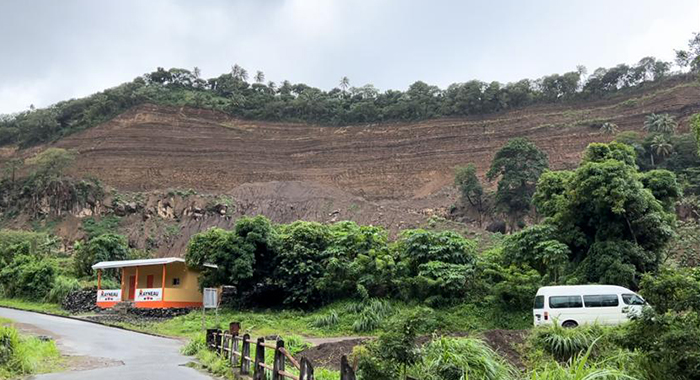By Troy Prince (Concerned Vincentian)
Rayneau Gajadhar, a renowned St. Lucian entrepreneur continues operations on a quarry in Richmond, St. Vincent and the Grenadines (SVG). This operation is ongoing amidst strong opposition from local environmental organisations and concerned citizens of SVG.
Such vehement opposition exist because the project seems to be on-going without an environmental impact assessment (EIA), a lack of public consultation and constant disregard for the well-being of all living organisms that will be immediately impacted by such a massive operation.
The quarry is now within its second year of preparatory works, and works are moving at a fast pace.
As recently Jan. 19, members of the North Leeward Heritage Preservation Front (NLHPF) visited the quarry site for a tour overseen by Rayneau. On this day, a barge was being offloaded with machinery and equipment for the plant setup and operation of the quarry.
This suggest that a lot more of the environmental concerns that were raised during protest actions by the NLHPF may soon be realised.
As a reminder, quarries can impact the environment in a number of ways. Some of the most harmful impacts on the environment from operating quarries include but aare not limited to the following:
- Water pollution — quarries can be a source of water pollution, as digging for of rocks can release harmful substances into the surrounding environment. As a result, quarries can pollute both surface water and groundwater. This impact is already evident. In a video posted on Facebook by Troy Prince on the Jan. 23, one can see the runoff from the quarry making its way into a nearby river causing it to be very murky. It appears as if nothing is being done to mitigate against such a harmful impact as Rayneau continues his operations.
- Deforestation — almost 60 acres of prime arable lands will be cleared to create this quarry which can disrupt pre-existing ecosystems, resulting in land degradation and loss of vegetation. Also, this displaces animals that live in the area and can leave them struggling to find food and shelter or force them into areas where they are seen as pests.
- Noise pollution — In a study on noise pollution at stone quarrying industry near Dharwad, research found when reading the noise levels from blasting activities that the noise ranged from 102.8 to 130.8 decibels. This is loud enough to hearing loss if workers are exposed to such loud noises without ear protection (International Journal of Advanced Research). In addition, noise pollution means animals will not hear predators approaching, but it can also mean that many predators cannot track prey if they cannot hear them, so this causes a disruption to the ecological balance.
- Dust pollution — as quarries are open-air mines, they can spread dust pollution. This can spread harmful compounds into the surrounding area. One such area that needs to be mentioned is the Richmond Vale Academy. This is a non-governmental organisation (NGO) located just about two minutes away from the quarrying site. This NGO is dedicated to create a sustainable future through ecological farming, environmental projects and volunteer programmes. It is already a match made in hell having such projects of conflicting nature in such close proximity. It would be interesting to see what the future of such an NGO looks like in the next decade with this quarry in its front yard causing layers of dust to settle in the area. Surely, this will kill plants as they can no longer photosynthesise as well as halt the growth of seedlings if they are completely sheltered from the sun. This can reduce crop yields and also leave animals struggling for food. A complete recipe for disaster.
In conclusion, operations of such a magnitude requires time and adequate planning. The installation of this quarry seems as if it was subject to irrational choice. The haste at which events unfolded and the manner in which they unfolded leaves the general public with loads of unanswered questions. Questions for which we may not get the investor or the government to ever answer. These adverse effects that are already evident are only minor since the quarry is still in its preparatory stage. There will be several radical changes to the environment once the project is fully up and running. These are serious causes for concerns, and the people of North Leeward are asking that this project be stopped until the EIA is done and the public is consulted.
The opinions presented in this content belong to the author and may not necessarily reflect the perspectives or editorial stance of iWitness News. Opinion pieces can be submitted to [email protected].






